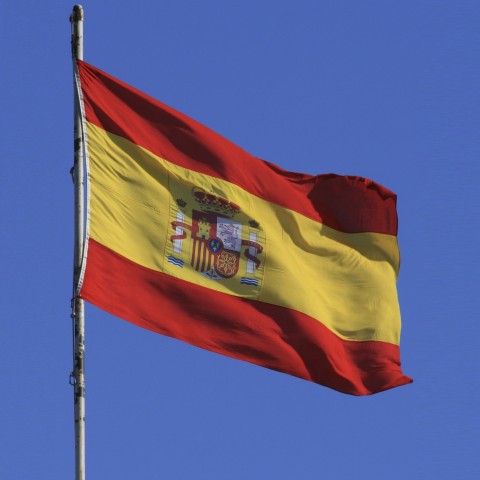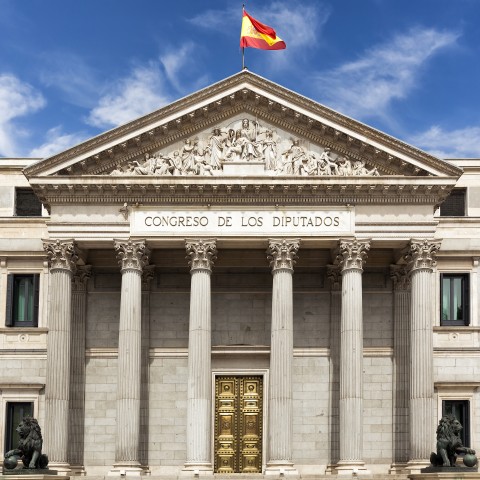
You’re learning to speak Spanish, and it’s going well. Your confidence is growing! So much so that you feel ready to share your experiences on social media—in Spanish.
At Learn Spanish, we make this easy for you to get it right the first time. Post like a boss with these phrases and guidelines, and get to practice your Spanish in the process.

1. Talking about Your Restaurant Visit in Mexican Spanish
Eating out is fun, and often an experience you’d like to share. Take a pic, and start a conversation on social media in Spanish. Your friend will be amazed by your language skills…and perhaps your taste in restaurants!
Antonio eats at a restaurant with his friends, posts an image of it, and leaves this comment:

POST
Let’s break down Antonio’s post.
Probando el restaurante italiano nuevo.
“Trying out the new Italian restaurant.”
1- Probando
First is an expression meaning “Trying out.”
This word in the gerund form is useful for short posts, because it doesn’t have to be conjugated. It can also be used when talking about trying out things such as electronic devices and cars.
2- el restaurante italiano nuevo.
Then comes the phrase – “the new Italian restaurant.”
In Spanish, most of the time, adjectives go after the noun. Italian restaurants are very popular in Mexico, especially if you are craving good pizza.
COMMENTS
In response, Antonio’s friends leave some comments.
1- ¡Me hubieras llevado!
His girlfriend, Cristina, uses an expression meaning – “You should have taken me!”
Cristina expresses here that she wishes she was with her boyfriend rather.
2- Se oye caro.
His college friend, Javier, uses an expression meaning – “Sounds expensive.”
Javier has reservations about the costliness of the food.
3- ¡Disfruta mucho!
His neighbor, Angelica, uses an expression meaning – “Enjoy (a lot)!”
Angelica simply wishes him a good time.
4- Estoy segura que les va a encantar.
His high school friend, Karen, uses an expression meaning – “I’m sure you guys will love it.”
Karen is also optimistic that this is an enjoyable event.
VOCABULARY
Find below the key vocabulary for this lesson:
restaurante: “restaurant”
probando: “testing, trying out”
nuevo, nueva: “new”
mucho: “a lot”
les va a encantar: “you / they are going to love it “
hubieras: “you should have”
caro, cara: “expensive “
So, let’s practice a bit. If a friend posted something about having dinner with friends, which phrase would you use?
Now go visit a Spanish restaurant, and wow the staff with your language skills!
2. Post about Your Mall Visit in Mexican Spanish
Another super topic for social media is shopping—everybody does it, most everybody loves it, and your friends on social media are probably curious about your shopping sprees! Share these Spanish phrases in posts when you visit a mall.
Cristina shop with her sister at the mall, posts an image of it, and leaves this comment:

POST
Let’s break down Cristina’s post.
Para las compras mi hermana es la mejor.
“Going shopping with my sister is the best.”
1- Para las compras
First is an expression meaning “For shopping.”
This phrase in English is a verb, but in Spanish it is a plural noun.
2- mi hermana es la mejor
Then comes the phrase – “my sister is the best.”
You can substitute the word for sister with any other feminine noun.
COMMENTS
In response, Cristina’s friends leave some comments.
1- ¡No, yo soy la mejor!
Her high school friend, Teresa, uses an expression meaning – “No, I’m the best!”
Teresa is playfully commenting, joking with her friend.
2- Momento familiar.
Her neighbor, Angelica, uses an expression meaning – “Family moment. ”
Angelica states the obvious – this is a warmhearted family thing.
3- ¡No te gastes todo tu salario!
Her college friend, Javier, uses an expression meaning – “Don’t spend all your salary!”
Javier playfully admonishes her not to overspend.
4- ¡Yo quiero ir!
Her boyfriend’s high school friend, Karen, uses an expression meaning – “I want to go!”
Karen takes part in the conversation by injecting this wish.
VOCABULARY
Find below the key vocabulary for this lesson:
compras: “shopping”
hermana: “sister”
mejor: “best”
salario: “salary”
momento familiar: “family time”
no te gastes: “do not spend”
quiero: “I want”
So, if a friend posted something about going shopping, which phrase would you use?
3. Talking about a Sport Day in Mexican Spanish
Sports events, whether you’re the spectator or the sports person, offer fantastic opportunity for great social media posts. Learn some handy phrases and vocabulary to start a sport-on-the-beach conversation in Spanish.
Antonio plays with his friends at the beach, posts an image of the team playing, and leaves this comment:

POST
Let’s break down Antonio’s post.
¡El equipo está listo para la victoria en la playa!
“The team is ready for victory on the beach!”
1- El equipo está listo
First is an expression meaning “The team is ready.”
Post this in Spanish to mean that you are ready to do something or ready for something. For example, a competition or a meal. It can also mean that you are looking forward to it.
2- para la victoria en la playa
Then comes the phrase – “for victory on the beach.”
Mexican beaches are famous tourist attractions because they’re beautiful and fun, which makes it an ideal place to have a sports match.
COMMENTS
In response, Antonio’s friends leave some comments.
1- Mucha suerte.
His supervisor, Pablo, uses an expression meaning – “Good luck”
This is a traditional, commonly-used reaction to a comment such as Antonio’s.
2- ¡Han entrenado duro!
His girlfriend, Cristina, uses an expression meaning – “You’ve trained hard!”
Cristina is sincere in her wish to encourage and support her boyfriend, and it shows with this comment!
3- Ojalá y no les llueva.
His girlfriend’s nephew, Paco, uses an expression meaning – “Hopefully it won’t rain.”
Paco is adding a less positive, but still realistic comment. Hopefully he’s not that cynical…
4- ¡Claro que estamos listos!
His college friend, Javier, uses an expression meaning – “Of course we’re ready!”
Javier is positive and optimistic that the game will go their way!
VOCABULARY
Find below the key vocabulary for this lesson:
equipo: “team”
listo: “ready”
playa: “beach”
victoria: “victory”
suerte: “luck”
claro: “of course”
ojalá: “hopefully”
Which phrase would you use if a friend posted something about sports?
But sport is not the only thing you can play! Play some music, and share it on social media.
4. Share a Song on Social Media in Mexican Spanish
Music is the language of the soul, they say. So, don’t hold back—share what touches your soul with your friends!
Cristina shares a song she just heard at a party, posts an image of the artist, and leaves this comment:

POST
Let’s break down Cristina’s post.
Para alegrarles el día, escuchen esta canción.
“To brighten your day, listen to this song.”
1- Para alegrarles el día,
First is an expression meaning “To brighten your day,.”
This phrase is used a lot on social media to share something you think people would like.
2- escuchen esta canción
Then comes the phrase – “listen to this song.”
You can use this phrase to recommend a song.
COMMENTS
In response, Cristina’s friends leave some comments.
1- ¡Gracias!
Her neighbor, Angelica, uses an expression meaning – “Thank you!”
Angelica is grateful, and says so in this short and sweet post!
2- Que moderna salió, tía.
Her nephew, Paco, uses an expression meaning – “You turned out to be a modern woman, aunt. ”
Paco gives his aunt a compliment, meaning he probably likes the song!
3- ¡Ah, de la fiesta!
Her boyfriend’s high school friend, Karen, uses an expression meaning – “Ah, from the party!”
Karen remembers this song from somewhere.
4- Que extraña música.
Her supervisor, Pablo, uses an expression meaning – “That’s strange music.”
Pablo is perhaps a bit old-fashioned, but his opinion is keeping the conversation going.
VOCABULARY
Find below the key vocabulary for this lesson:
canción: “song”
alegrar: “to lighten up”
moderna: “modern”
tía: “tía”
fiesta: “party”
extraño, extraña: “strange”
música: “music”
Which song would you share? And what would you say to a friend who posted something about sharing music or videos?
Now you know how to start a conversation about a song or a video on social media!
5. Mexican Spanish Social Media Comments about a Concert
Still on the theme of music—visiting live concerts and shows just have to be shared with your friends. Here are some handy phrases and vocab to wow your followers in Spanish!
Antonio goes to a concert, posts an image of the band, and leaves this comment:

POST
Let’s break down Antonio’s post.
¡La banda se oye mejor en vivo, inolvidable!
“The band sounds better live. Unforgettable!”
1- La banda se oye mejor en vivo
First is an expression meaning “The band sounds better live.”
You can change the noun to express that something is best experienced in person.
2- inolvidable
Then comes the phrase – “unforgettable.”
This is mainly used to express that something is really good, but it can also be used to express that something is very bad.
COMMENTS
In response, Antonio’s friends leave some comments.
1- Ya está muy viejo para esos conciertos.
His girlfriend’s nephew, Paco, uses an expression meaning – “You’re too old for those concerts.”
It seems the band is more popular with young people – or people younger than Antonio! Paco can be a bit negative with this comment.
2- ¡Vas a ser el más viejo ahí!
His girlfriend’s high school friend, Teresa, uses an expression meaning – “You’ll be the oldest one there!”
Teresa agrees with Paco, though, so who knows? Is Antonio too old to attend these concerts, or are these two just making conversation?
3- ¡No hagas caso, vamos a disfrutar!
His college friend, Javier, uses an expression meaning – “Don’t listen. Let’s enjoy!”
Javier clearly feel that Teresa and Paco’s opinions don’t really matter in this instance, and recommends that they just enjoy the show. Good advice!
4- Una de las mejores bandas.
His high school friend, Karen, uses an expression meaning – “One of the best bands.”
Karen feels optimistic about the quality of the band.
VOCABULARY
Find below the key vocabulary for this lesson:
banda: “band”
inolvidable: “unforgettable”
concierto: “concert”
disfrutar: “to enjoy”
una de las mejores: “one of the best”
se oye mejor: “it sounds better”
en vivo: “live”
If a friend posted something about a concert, which phrase would you use?
6. Talking about an Unfortunate Accident in Mexican Spanish
Oh dear. You broke something by accident. Use these Spanish phrases to start a thread on social media. Or maybe just to let your friends know why you are not contacting them!
Cristina accidentally breaks her mobile phone, and leaves this comment:

POST
Let’s break down Cristina’s post.
Qué lástima, mi celular ha muerto.
“What a shame. My cellphone (has) died.”
1- Qué lástima
First is an expression meaning “What a pity”
A phrase used to express that something unfortunate has happened.
2- mi celular ha muerto
Then comes the phrase – “my cellphone has died.”
A phrase used to express that the “cellphone” isn’t working anymore. If ‘cellphone’ was changed to another object, it would also mean that that object no longer works.
COMMENTS
In response, Cristina’s friends leave some comments.
1- Nunca te duran.
Her nephew, Paco, uses an expression meaning – “You never make them last. ”
Paco is being negative in his reaction with this criticism, or perhaps this is just the way he and his aunt banter with one another?
2- Ya tienes excusa para comprar el más nuevo.
Her high school friend, Teresa, uses an expression meaning – “Now you have an excuse to buy the newest one.”
Teresa offers Cristina a positive out – the phone can be replaced with a better one.
3- ¡Espero que no haya sido a propósito!
Her boyfriend, Antonio, uses an expression meaning – “I hope it wasn’t on purpose!”
Antonio seems to comment in response to Teresa’s post! He seems to be making conversation.
4- Se puede arreglar.
Her supervisor, Pablo, uses an expression meaning – “It can be fixed.”
Pablo has sober advice.
VOCABULARY
Find below the key vocabulary for this lesson:
qué lástima: “what a pity, what a shame”
celular: “cellphone”
nunca: “never”
excusa: “excuse”
comprar: “to buy”
arreglar: “to fix”
a propósito: “on purpose”
If a friend posted something about having broken something by accident, which phrase would you use?
So, now you know how to discuss an accident in Spanish. Well done!
7. Chat about Your Boredom on Social Media in Mexican Spanish
Sometimes, we’re just bored with how life goes. And to alleviate the boredom, we write about it on social media. Add some excitement to your posts by addressing your friends and followers in Spanish!
Antonio gets bored at home, and leaves this comment:

POST
Let’s break down Antonio’s post.
Estoy aburrido, ¿qué recomiendan?
“I’m bored, what do you recommend (to do)?”
1- Estoy aburrido
First is an expression meaning “I’m bored.”
This is commonly used on social media to invite people to start an activity.
2- ¿qué recomiendan?
Then comes the phrase – “what do you recommend?.”
This question can be asked for opinions, not only about activities, but of other things such as food and movies.
COMMENTS
In response, Antonio’s friends leave some comments.
1- ¡Ven y nos aburrimos juntos!
His girlfriend, Cristina, uses an expression meaning – “Come and let’s be bored together!”
Cristina is being a good girlfriend and has sympathy with his feelings. She offers a good solution!
2- Ponte a limpiar la casa.
His college friend, Javier, uses an expression meaning – “Get (on) to cleaning the house.”
Javier is a clown and suggests that Antonio engages in housecleaning. He really must be joking…
3- Podrías venir a trabajar extra…
His supervisor, Pablo, uses an expression meaning – “You could come work overtime…”
Pablo has a sober solution, but one that Antonio is unlikely to take, right?
4- ¡Yo tampoco quiero estar aburrida!
His girlfriend’s high school friend, Teresa, uses an expression meaning – “I don’t want to be bored either!”
Teresa shares a personal experience, a good way to participate in a conversation.
VOCABULARY
Find below the key vocabulary for this lesson:
aburrido, aburrida: “bored”
qué: “what”
casa: “house”
venir: “to come”
limpiar: “to clean”
recomendar: “to recommend”
trabajar extra: “to work overtime”
If a friend posted something about being bored, which phrase would you use?
Still bored? Share another feeling and see if you can start a conversation!
8. Exhausted? Share It on Social Media in Mexican Spanish
Sitting in public transport after work, feeling like chatting online? Well, converse in Spanish about how you feel, and let your friends join in!
Cristina feels exhausted after a long day at work, posts an image of herself looking tired, and leaves this comment:

POST
Let’s break down Cristina’s post.
¡Por fin puedo ir a descansar a mi casa!
“Finally, I can go rest at home!”
1- Por fin
First is an expression meaning “At last.”
This phrase is used to express relief over something that is finally done or finished.
2- puedo ir a descansar a mi casa
Then comes the phrase – “I can go rest at home.”
Use this pattern when you are allowing yourself to do something.
COMMENTS
In response, Cristina’s friends leave some comments.
1- Te estaré esperando con la cena.
Her boyfriend, Antonio, uses an expression meaning – “I’ll be waiting with dinner.”
Antonio is being a boyfriend from heaven!
2- ¡Qué tarde saliste del trabajo!
Her neighbor, Angelica, uses an expression meaning – “You got out really late!”
Angelica feels sorry for Cristina that she had to leave work so late.
3- ¡Ya mero serás libre!
Her high school friend, Teresa, uses an expression meaning – “You’re almost free!”
There is a silver lining to this dark cloud! Teresa kindly reminds Cristina that the suffering is almost over.
4- Todos tenemos que trabajar duro.
Her college friend, Javier, uses an expression meaning – “We all have to work hard.”
Javier reminds her that she’s not alone in her predicament.
VOCABULARY
Find below the key vocabulary for this lesson:
por fin: “at last, finally”
descansar: “to rest”
trabajo: “job, work”
ya mero: “almost”
libre: “free”
te estaré esperando: “I will be waiting for you”
tarde: “late”
If a friend posted something about being exhausted, which phrase would you use?
Now you know how to say you’re exhausted in Spanish! Well done.
9. Talking about an Injury in Mexican Spanish
So life happens, and you manage to hurt yourself during a soccer game. Very Tweet-worthy! Here’s how to do it in Spanish.
Antonio suffers a painful injury, posts an image of it, and leaves this comment:

POST
Let’s break down Antonio’s post.
¡El entrenamiento de fútbol me ha costado una pierna, literalmente!
“Soccer training has cost me a leg, literally!”
1- El entrenamiento de fútbol me ha costado una pierna
First is an expression meaning “Soccer training has cost me a leg.”
You can change the word leg for another noun in this phrase to express that something has cost you more than money.
2- literalmente
Then comes the phrase – “literally.”
An adverb that means something is in a literal manner.
COMMENTS
In response, Antonio’s friends leave some comments.
1- Ya no puede hacer ejercicios pesados.
His girlfriend’s nephew, Paco, uses an expression meaning – “You can’t do heavy exercises.”
Paco feels the need to remind Antonio of something he undoubtedly knows.
2- ¿Qué pasó?
His girlfriend’s high school friend, Teresa, uses an expression meaning – “What happened?”
Teresa shows her concern by being interested in the news. She asks for more details.
3- Estoy segura que no es tan grave.
His high school friend, Karen, uses an expression meaning – “I’m sure it’s not too serious.”
Use this expression to show you are feeling optimistic.
4- Por eso se retiran jóvenes los futbolistas.
His college friend, Javier, uses an expression meaning – “That’s why soccer players retire young.”
Javier doesn’t feel positive about professional soccer players’ careers.
VOCABULARY
Find below the key vocabulary for this lesson:
entrenamiento: “training”
me ha costado: “It has cost me”
pierna: “leg”
grave: “serious”
¿Qué pasó?: “What happened?”
joven: “young”
If a friend posted something about being injured, which phrase would you use?
We love to share our fortunes and misfortunes; somehow that makes us feel connected to others.
10. Starting a Conversation Feeling Disappointed in Mexican Spanish
Sometimes things don’t go the way we planned. Share your disappointment about this with your friends!
Cristina feels disappointed about today’s weather, posts an image of it, and leaves this comment:

POST
Let’s break down Cristina’s post.
Yo que quería salir pero esta lluvia no se va a ir.
“I wanted to go out, but this rain isn’t going to leave.”
1- Yo que quería
First is an expression meaning “I wanted.”
This phrase is used to express that you wanted something or wanted to do something but there is a factor that is not letting you achieve it.
2- salir pero esta lluvia no se va a ir
Then comes the phrase – “to go out but this rain isn’t going to leave.”
Place the reason why you couldn’t get or do something after ‘but’.
COMMENTS
In response, Cristina’s friends leave some comments.
1- Pero si podemos hacer algo adentro.
Her boyfriend, Antonio, uses an expression meaning – “But we can do something indoors.”
Antonio is being supportive by suggesting that they turn the situation around. Good for him!
2- Podemos ir al cine.
Her boyfriend’s high school friend, Karen, uses an expression meaning – “We can go to the movies.”
Karen is also offering a suggestion to alleviate Cristina’s problem.
3- Ten mucho cuidado si vas a manejar.
Her neighbor, Angelica, uses an expression meaning – “Be very careful if you’re going to drive.”
Angelica is more concerned with Cristina’s safety on the wet roads.
4- Nos arruinó el fin de semana.
Her college friend, Javier, uses an expression meaning – “It ruined our weekend. ”
Javier commiserates by sharing a personal experience. It also rained on his parade!
VOCABULARY
Find below the key vocabulary for this lesson:
salir: “to get out, to go out”
lluvia: “rain”
adentro: “inside, indoors”
cine: “movies”
manejar: “to drive”
arruinar: “to ruin, to mess up”
fin de semana: “weekend”
How would you comment in Spanish when a friend is disappointed?
Not all posts need to be about a negative feeling, though!
11. Talking about Your Relationship Status in Mexican Spanish
Don’t just change your relationship status in Settings, talk about it!
Antonio changes his status to “In a relationship”, posts an image of it, and leaves this comment:

POST
Let’s break down Antonio’s post.
¡Mi vida ya no será igual con alguien especial a mi lado!
“My life won’t be the same with someone special by my side!”
1- Mi vida ya no será igual
First is an expression meaning “My life will not be the same.”
This phrase is used a lot to express that something has happened that will impact you greatly. It could be something with either a negative or positive impact.
2- con alguien especial a mi lado
Then comes the phrase – “with someone special by my side.”
In Mexican culture, couples like to commemorate the day on which they began their relationships. They like to give each other presents when they celebrate each month’s anniversary.
COMMENTS
In response, Antonio’s friends leave some comments.
1- ¿Quién es la suertuda?
His high school friend, Karen, uses an expression meaning – “Who’s the lucky one?”
Karen is teasing the couple by wondering who is lucky for having met who.
2- ¡Ya era hora de que te calmaras!
His girlfriend’s high school friend, Teresa, uses an expression meaning – “It’s about time you settled down!”
Teresa feels the couple should be together, that’s clear!
3- Milagro que alguien te va a aguantar.
His college friend, Javier, uses an expression meaning – “It’s a miracle that someone would put up with you.”
Javier makes fun of his friend, as guys often do with sensitive matters.
4- Qué bueno que te da gusto.
His girlfriend, Cristina, uses an expression meaning – “It’s a good thing you’re glad.”
Cristina’s comment is rather humorous. Imagine Antonio was unhappy about having a new girlfriend!
VOCABULARY
Find below the key vocabulary for this lesson:
vida: “life”
igual : “the same”
alguien: “someone, somebody”
especial: “special”
suertudo, suertuda: “lucky”
milagro: “miracle”
aguantar: “put up with”
What would you say in Spanish when a friend changes their relationship status?
Being in a good relationship with someone special is good news – don’t be shy to spread it!
12. Post about Getting Married in Mexican Spanish
Wow, so things got serious, and you’re getting married. Congratulations! Or, your friend is getting married, so talk about this in Spanish.
Cristina is getting married today, so she eaves this comment:

POST
Let’s break down Cristina’s post.
¡Hoy es el día más importante de mi vida, mi boda!
“Today is the most important day of my life. My wedding!”
1- Hoy es el día más importante de mi vida
First is an expression meaning “Today is the most important day of my life.”
A phrase commonly used to express that something important is going to happen on that day.
2- mi boda
Then comes the phrase – “my wedding.”
Replace this phrase with any other event or feeling that is important to you at the moment.
COMMENTS
In response, Cristina’s friends leave some comments.
1- ¡El día más importante para los dos!
Her husband, Antonio, uses an expression meaning – “The most important day for both of us!”
Antonio agrees with his wife-to-be – a very good thing! – and reminds her that this is a big day not only for her.
2- Les deseo lo mejor en este día tan especial.
Her neighbor, Angelica, uses an expression meaning – “I wish you all the best on this special day.”
A warmhearted wish for the couple.
3- ¡Estoy lista para la fiesta!
Her high school friend, Teresa, uses an expression meaning – “I’m ready for the party!”
Use this expression to be funny.
4- Muchas felicidades, lo mejor aún está por venir.
Her husband’s high school friend, Karen, uses an expression meaning – “Congratulations. The best has yet to come.”
Karen is optimistic that this is a good union and congratulates the couple accordingly.
VOCABULARY
Find below the key vocabulary for this lesson:
día : “day”
importante: “important”
boda: “wedding”
listo, lista: “ready”
felicidades: “congratulations”
venir: “to come”
aún: “yet, still”
How would you respond in Spanish to a friend’s post about getting married?
For the next topic, fast forward about a year into the future after the wedding…
13. Announcing Big News in Mexican Spanish
Wow, huge stuff is happening in your life! Announce it in Spanish.
Antonio finds out he and his wife are going to have a baby, posts an image of them, and leaves this comment:

POST
Let’s break down Antonio’s post.
¡Vamos a tener un bebé!
“We are going to have a baby!”
1- Vamos a
First is an expression meaning “We are going to .”
Although this expression has the plural form of the verb “to go” it can mean “we are going to”. A verb is added after to express what you are going to do as a group.
2- tener un bebé
Then comes the phrase – “have a baby.”
You can also change the word for “baby” to another noun. For example, a test, a puppy, a fun day, etc.
COMMENTS
In response, Antonio’s friends leave some comments.
1- ¡Qué alegría, muy buenas noticias!
His neighbor, Angelica, uses an expression meaning – “What joy, this is very good news!”
This is a spontaneous, warmhearted comment.
2- ¡Yo quiero ser la tía preferida!
His wife’s high school friend, Teresa, uses an expression meaning – “I want to be the favorite aunt!”
Teresa is excited about the news, and hopes to have a big role in the little one’s life.
3- ¡Felicidades! Han de estar muy emocionados.
His high school friend, Karen, uses an expression meaning – “Congratulations! You two must be very excited.”
Karen is also pleased about the news, imagining their joy too.
4- Espero que no le pongan un nombre raro.
His nephew, Paco, uses an expression meaning – “I hope you don’t give him/her a weird name.”
Paco is probably joking with the expecting parents. Otherwise he’s a rather miserable little chap!
VOCABULARY
Find below the key vocabulary for this lesson:
tener: “to have”
bebé: “baby”
alegría : “joy, happiness”
buenas noticias: “good news”
preferido, preferida: “favorite”
nombre: “name”
raro, rara: “weird”
Which phrase would you choose when a friend announces their pregnancy on social media?
So, talking about a pregnancy will get you a lot of traction on social media. But wait till you see the responses to babies!
14. Posting Mexican Spanish Comments about Your Baby
Your bundle of joy is here, and you cannot keep quiet about it! Share your thoughts in Spanish.
Cristina plays with her baby, posts an image of sweet little one, and leaves this comment:

POST
Let’s break down Cristina’s post.
Mi tesoro está muy contento con su mami.
“My precious is very happy with his mommy.”
1- Mi tesoro
First is an expression meaning “My precious.”
This phrase literally says “my treasure” but it is a common phrase of affection for someone. Similar to – my darling.
2- está muy contento con su mami
Then comes the phrase – “he/she is very happy with his/her mommy..”
In Mexican culture it is common to have a first name and a middle name along with two family names. One is your father’s family name and the other is your mother’s family name.
COMMENTS
In response, Cristina’s friends leave some comments.
1- ¡Cuando necesiten una niñera yo estoy disponible!
Her neighbor, Angelica, uses an expression meaning – “When you need a nanny I’m available!”
Angelica is helpful and really eager to be part of the kiddo’s life.
2- ¡Qué hermoso!
Her husband’s high school friend, Karen, uses an expression meaning – “So beautiful!”
Karen adds a positive, appreciative comment.
3- ¡Yo también quiero uno!
Her high school friend, Teresa, uses an expression meaning – “I also want one!”
Teresa is so inspired by the look of this baby that she wants one too.
4- ¿A quién le toca cambiar el pañal?
Her nephew, Paco, uses an expression meaning – “Whose turn is it to change the diaper?”
Paco is probably teasing the couple with this comment.
VOCABULARY
Find below the key vocabulary for this lesson:
tesoro: “treasure”
contento, contenta: “happy”
niñera: “nanny, babysitter”
disponible: “available”
hermoso, hermosa: “beautiful”
cambiar: “change”
a quién le toca: “who’s turn is it”
If your friend is the mother or father, which phrase would you use on social media?
Congratulations, you know the basics of chatting about a baby in Spanish! But we’re not done with families yet…
15. Mexican Spanish Comments about a Family Reunion
Family reunions – some you love, some you hate. Share about it on your feed.
Antonio goes to a family gathering, posts an image of it, and leaves this comment:

POST
Let’s break down Antonio’s post.
¡La mejor carne asada se come en familia!
“The best barbecue is eaten with family!”
1- La mejor carne asada
First is an expression meaning “The best barbecue.”
Mexican “barbecue” is a very popular activity for families and friends, especially during summer. The participants contribute by bringing food or drinks, and everyone enjoys long talks during and after eating.
2- se come en familia
Then comes the phrase – “is eaten with family.”
Mexican families tend to be very united, not only with close relatives and friends, but also with distant relatives. This is why reunions and events often have a large number of guests.
COMMENTS
In response, Antonio’s friends leave some comments.
1- ¡Eso es verdad!
His neighbor, Angelica, uses an expression meaning – “That’s true!”
Angelica agrees with Antonio.
2- Pensé que era la que sabe rica.
His nephew, Paco, uses an expression meaning – “I thought it’s the one that tastes good.”
Paco must be a clown…otherwise he’s a wise-nose and a know-it-all! He takes part in the conversation with wry, dry wit.
3- ¡Yo soy casi de la familia, pero no me invitan!
His wife’s high school friend, Teresa, uses an expression meaning – “I’m almost family, but you don’t invite me!”
Teresa takes part in the conversation, probably with a light heart.
4- Yo también quiero invitación para la próxima carne asada.
His high school friend, Karen, uses an expression meaning – “I want an invitation for the next barbecue, too.”
The friends all want in on this party!
VOCABULARY
Find below the key vocabulary for this lesson:
carne asada: “barbecue”
familia: “family”
verdad: “_true”
invitar: “to invite”
invitación: “invitation”
próximo: próxima: “next”
también: “too, also”
Which phrase is your favorite to comment on a friend’s photo about a family reunion?
16. Post about Your Travel Plans in Mexican Spanish
So, the family are going on holiday. Do you know how to post and leave comments in Spanish about being at the airport, waiting for a flight?
Cristina waits at the airport for her flight, posts an image of it, and leaves this comment:

POST
Let’s break down Cristina’s post.
¡Me choca cuando se atrasan los vuelos!
“I hate it when flights are delayed!”
1- Me choca cuando
First is an expression meaning “I hate it when.”
This is a very common phrase used in informal conversations. It literally means “It crashes to me when…”, and it is used when something bothers you, or when you hate something or someone.
2- se atrasan los vuelos
Then comes the phrase – “flights are delayed.”
Mexico is among one of the countries with the most airports in the world. 58 of its airports are international airports.
COMMENTS
In response, Cristina’s friends leave some comments.
1- Por favor avisa cuando vayas a abordar.
Her neighbor, Angelica, uses an expression meaning – “Please let me know when you are going to board.”
Angelica probably wants to be sure that Cristina is OK, therefore she asks to be kept up to date.
2- ¡Mejor tarde que nunca!
Her husband’s high school friend, Karen, uses an expression meaning – “Better late than never!”
Karen points out a positive aspect to the situation.
3- Voy a estar esperando mi recuerdo.
Her nephew, Paco, uses an expression meaning – “I will be waiting for my souvenir.”
Paco is dropping a hint here! He clearly expects to benefit from this holiday of his family’s.
4- Ese aeropuerto es terrible, buena suerte.
Her husband’s college friend, Javier, uses an expression meaning – “That airport is terrible. Good luck.”
Javier empathises by agreeing with Cristina about the service at the airport.
VOCABULARY
Find below the key vocabulary for this lesson:
vuelo: “flight”
abordar: “to board”
tarde: “late”
nunca: “never”
aeropuerto: “airport”
recuerdo: “souvenir”
terrible: “terrible”
Choose and memorize your best airport phrase in Spanish!
Hopefully the rest of the trip is better!
17. Posting about an Interesting Find in Mexican Spanish
So maybe you’re strolling around at a local market, and find something interesting. Here are some handy Spanish phrases!
Antonio finds an unusual item at a local market, posts an image of it, and leaves this comment:

POST
Let’s break down Antonio’s post.
No tengo ni idea qué es esto pero se ve interesante.
“I have no idea what this is, but it looks interesting.”
1- No tengo ni idea
First is an expression meaning “I have no idea.”
It literally translates to “I don’t have no idea”. This phrase has two negatives, but it is considered grammatically correct in the Spanish language.
2- qué es esto pero se ve interesante
Then comes the phrase – “what this is but it looks interesting.”
The phrase “it looks interesting” in Spanish is used sometimes sarcastically. So pay attention to the speaker’s facial expression while they’re saying it.
COMMENTS
In response, Antonio’s friends leave some comments.
1- Parece ser una antigüedad.
His supervisor, Pablo, uses an expression meaning – “It seems to be an antique.”
Pablo seems to know about these things, but he’s not sure.
2- Se ve rara, con razón nadie la ha comprado.
His college friend, Javier, uses an expression meaning – “It looks weird. No wonder nobody has bought it.”
Javier doesn’t seem to think much of Antonio’s find.
3- En ese mercado siempre hay cosas interesantes.
His high school friend, Karen, uses an expression meaning – “There are always interesting things in that market.”
Karen feels optimistic that the find is at least interesting.
4- Tal vez tiene valor histórico.
His wife, Cristina, uses an expression meaning – “Maybe it has historical value. ”
Cristina wants to be positive about Antonio’s find.
VOCABULARY
Find below the key vocabulary for this lesson:
ni idea: “no idea”
antigüedad: “antiquity”
raro, rara: “weird”
mercado: “market”
siempre: “always”
cosa: “thing”
valor: “value”
Which phrase would you use to comment on a friend’s interesting find?
Perhaps you will even learn the identity of your find! Or perhaps you’re on holiday, and visiting interesting places…
18. Post about a Sightseeing Trip in Mexican Spanish
Let your friends know what you’re up to in Spanish, especially when visiting a remarkable place! Don’t forget the photo.
Cristina visits a famous landmark, posts an image of it, and leaves this comment:

POST
Let’s break down Cristina’s post.
¡Estoy tan agradecida de poder visitar este bello lugar!
“I am so grateful to be able to visit this beautiful place!”
1- Estoy tan agradecida
First is an expression meaning “I am so grateful.”
A common, formal phrase used to express gratitude for something or towards someone, or to express happiness over something, someone, or a situation.
2- de poder visitar este bello lugar
Then comes the phrase – “to be able to visit this beautiful place.”
Just change this part of the expression to refer to the subject of your gratitude.
COMMENTS
In response, Cristina’s friends leave some comments.
1- ¡Qué gran oportunidad!
Her neighbor, Angelica, uses an expression meaning – “What a great opportunity!”
Angelica basically agrees with Cristina about the experience.
2- ¡No te vayas a quedar ahí para siempre!
Her high school friend, Teresa, uses an expression meaning – “Don’t stay there forever!”
Teresa is making a joke about Cristina’s love of the beautiful place.
3- ¡Yo me uniré al siguiente viaje!
Her husband’s high school friend, Karen, uses an expression meaning – “I will join you on your next trip!”
Karen hopes to go there too.
4- Ese es un monumento cultural muy importante.
Her supervisor, Pablo, uses an expression meaning – “That is a very important cultural monument.”
Pablo shares his knowledge of the landmark, and makes an interesting contribution to the conversation.
VOCABULARY
Find below the key vocabulary for this lesson:
agradecido, agradecida: “grateful”
visitar: “to visit”
bello lugar: “beautiful place”
para siempre: “forever”
me uniré: “I will join”
viaje: “trip”
monumento: “monument”
Which phrase would you prefer when a friend posts about a famous landmark?
Share your special places with the world. Or simply post about your relaxing experiences.
19. Post about Relaxing Somewhere in Mexican Spanish
So you’re doing nothing yet you enjoy that too? Tell your social media friends about it in Spanish!
Antonio relaxes at a beautiful place, posts an image of it, and leaves this comment:

POST
Let’s break down Antonio’s post.
Me merecía un buen descanso en un paraíso.
“I deserved a good rest in paradise.”
1- Me merecía
First is an expression meaning “I deserved.”
The phrase is translated as “I deserve,” but it is interpreted as rightfully deserving of something. It is commonly used after receiving or experiencing something that you had longed for.
2- un buen descanso en un paraíso
Then comes the phrase – “a good rest in paradise.”
Mexico is well known for its beautiful beaches, the most famous of which are Cancun, Mazatlan, Puerto Vallarta and Acapulco. Tourists come from all over the world to enjoy the Mexican beaches.
COMMENTS
In response, Antonio’s friends leave some comments.
1- No creo que sea tan merecido.
His college friend, Javier, uses an expression meaning – “I don’t think you deserve it that much.”
Javier is being frivolous as he partakes in the conversation. He makes fun of his friend.
2- Todos lo merecemos de vez en cuando.
His neighbor, Angelica, uses an expression meaning – “We all deserve it once in a while.”
Angelica disagrees with Javier, feeling that Antonio probably deserves relaxation sometimes!
3- Es un buen lugar para relajarse.
His high school friend, Karen, uses an expression meaning – “It is a good place to relax.”
Karen feels the place contributes to relaxation.
4- Que mal si está lleno de turistas.
His wife’s nephew, Paco, uses an expression meaning – “Too bad if it’s full of tourists.”
Paco is adding the note of negativity or criticism to the conversation – who knows what’s up with this nephew of Cristina’s!
VOCABULARY
Find below the key vocabulary for this lesson:
descanso: “break”
paraíso: “paradise”
merecido, merecida: “deserved”
relajarse: “to relax “
lleno, llena: “full”
turista: “tourist”
todos: “everyone, all”
Which phrase would you use to comment in a friend’s feed?
The break was great, but now it’s time to return home.
20. What to Say in Mexican Spanish When You’re Home Again
And you’re back! What will you share with friends and followers?
Cristina returns home after a vacation, posts an image of it, and leaves this comment:

POST
Let’s break down Cristina’s post.
Cansada pero feliz de estar de vuelta en la casa.
“Tired but happy to be back home.”
1- Cansada pero feliz
First is an expression meaning “Tired but happy.”
A commonly used phrase on social media that is used after finishing an activity. In this example, the first word is a feminine adjective that can also be changed to masculine.
2- de estar de vuelta en la casa
Then comes the phrase – “to be back home.”
This phrase can be changed to express why you are happy. You can change the verb and the noun to fit your situation.
COMMENTS
In response, Cristina’s friends leave some comments.
1- ¡Bienvenida de vuelta!
Her neighbor, Angelica, uses an expression meaning – “Welcome back!”
Angelica uses a warmhearted, traditional and commonly-used response to Cristina’s news.
2- Ahora empieza la tarea de desempacar.
Her college friend, Javier, uses an expression meaning – “The task of unpacking starts now.”
Javier reminds them of reality.
3- Espero que no se les haya olvidado mi regalo.
Her nephew, Paco, uses an expression meaning – “I hope you did not forget my gift.”
Paco seems to think only of himself with this comment!
4- Quiero saber todo sobre el viaje.
Her husband’s high school friend, Karen, uses an expression meaning – “I want to hear all about your trip.”
Karen is excited to hear the details of the vacation.
VOCABULARY
Find below the key vocabulary for this lesson:
cansado, cansada: “tired”
feliz: “happy”
bienvenido, bienvenida: “welcome”
tarea: “task, chore”
desempacar: “unpack”
sobre: “about”
oír: “to hear”
How would you welcome a friend back from a trip?
What do you post on social media during a public commemoration day such as Independence Day?
21. It’s Time to Celebrate in Mexican Spanish
It’s an historic day and you wish to post something about it on social media. What would you say?
Antonio watches Independence Day fireworks show, posts an image of it, and leaves this comment:

POST
Let’s break down Antonio’s post.
¡Viva la Independencia!
“Hurray for Independence!”
1- Viva
First is an expression meaning “Hurray.”
This can mean “Long live…”,”Hurray”, and “Hail”. This word is very common during national holidays and is used to express support over a person and/or festivity.
2- la Independencia
Then comes the phrase – “the Independence.”
Mexican Independence Day is the biggest celebration in the country. It commemorates the beginning of the war against the Spaniards that ruled over Mexico. Fireworks are displayed in every city and events are organized by the local government for the night of September 15.
COMMENTS
In response, Antonio’s friends leave some comments.
1- ¡Qué empiece la celebración!
His wife’s high school friend, Teresa, uses an expression meaning – “Let the celebration begin!”
Teresa is equally exuberant about the big festivities.
2- ¡Feliz día de la Independencia!
His high school friend, Karen, uses an expression meaning – “Happy Independence Day!”
Karen comments with the traditional greeting used on this day.
3- Cuidado con los escandalosos
His college friend, Javier, uses an expression meaning – “Beware of the boisterous.”
Javier reminds Antonio that some participants in the festivities can be over-excited!
4- ¡Es el día en que todos somos patrióticos!
His wife’s high school friend, Teresa, uses an expression meaning – “It’s the day we’re all patriotic!”
This is pointing out a fact about the day for all Mexicans.
VOCABULARY
Find below the key vocabulary for this lesson:
viva: “hurray”
independencia: “independence”
celebración: “celebration”
escandaloso, escandalosa: “boisterous”
patriótico, patriótica: “patriotic”
empezar: “to begin”
cuidado: “watch out”
If a friend posted something about a holiday, which phrase would you use?
Independence Day and other public commemoration days are not the only special ones to remember!
22. Posting about a Birthday on Social Media in Mexican Spanish
Your friend or you are celebrating your birthday in an unexpected way. Be sure to share this on social media!
Cristina attends her surprise birthday party, posts an image of it, and leaves this comment:

POST
Let’s break down Cristina’s post.
¡Gracias a todos por la fiesta de cumpleaños sorpresa!
“Thank you all for the surprise birthday party!”
1- Gracias a todos por
First is an expression meaning “Thank you all for.”
It is a common practice to thank a person or people on social media for something they have done for you. The word “all” can be changed to another noun to thank someone or something particularly.
2- la fiesta de cumpleaños sorpresa
Then comes the phrase – “the surprise birthday party. .”
This can be changed to the specific thing you want to thank people for. For example, taking me to a concert, the support I have received, the great present, etc.
COMMENTS
In response, Cristina’s friends leave some comments.
1- ¡Feliz cumpleaños!
Her neighbor, Angelica, uses an expression meaning – “Happy birthday!”
This is the universal, traditional greeting on any birthday.
2- Gracias a todos por contribuir para la fiesta.
Her husband, Antonio, uses an expression meaning – “Thank you all for contributing to the party.”
Antonio is not just responding to Cristina – he makes use of the opportunity to express his gratitude to all their friends.
3- ¡Espero y cumplas muchos años más!
Her husband’s high school friend, Karen, uses an expression meaning – “I hope you have many more birthdays!”
Karen extends a warm wish to Cristina on her birthday.
4- ¿Verdad que mi pastel estuvo bien rico?
Her high school friend, Teresa, uses an expression meaning – “My cake was very tasty, right?”
Presumably Teresa baked the cake. If she didn’t, she means to be funny with this comment.
VOCABULARY
Find below the key vocabulary for this lesson:
fiesta: “party”
sorpresa: “surprise”
cumpleaños: “birthday”
contribuir: “to contribute”
años: “years”
pastel: “cake”
rico, rica: “tasty”
If a friend posted something about birthday greetings, which phrase would you use?
23. Talking about New Year on Social Media in Mexican Spanish
Impress your friends with your Spanish New Year’s wishes this year. Learn the phrases easily!
Antonio celebrates the New Year, posts an image of it, and leaves this comment:

POST
Let’s break down Antonio’s post.
Un brindis por un próspero año nuevo.
“A toast to a prosperous New Year.”
1- Un brindis por
First is an expression meaning “A toast to.”
As in many countries, toasts are offered during special occasions and are mainly done with alcoholic drinks. The word used during toasts in Mexico literally means “health” (in English the word is “cheers” ) as toasts are commonly done to wish good things for a person’s well being.
2- un próspero año nuevo
Then comes the phrase – “a prosperous New Year..”
New Year’s Eve is also a big celebration in Mexico. Young adults and teenagers prefer to celebrate this holidays among friends and romantic partners.
COMMENTS
In response, Antonio’s friends leave some comments.
1- ¡Salud! ¡Feliz Año Nuevo!
His high school friend, Karen, uses an expression meaning – “Cheers! Happy New Year!”
This is a casual, optimistic and commonly-used New Year’s wish.
2- ¡Brindemos por todas las metas que no vamos a cumplir!
His wife’s high school friend, Teresa, uses an expression meaning – “Let’s toast to all the goals we will not achieve!”
Teresa’s comment is realistic and funny at the same time!
3- Siempre nos proponemos las mismas metas.
His college friend, Javier, uses an expression meaning – “We always propose the same goals.”
Javier makes conversation with this comment.
4- Espero que se propongan mejorar en el trabajo.
His supervisor, Pablo, uses an expression meaning – “I hope you propose to improve at work. ”
Pablo talks work…
VOCABULARY
Find below the key vocabulary for this lesson:
brindis: “toast”
próspero, próspera: “prosperous”
salud: “cheers”
Año Nuevo: “New Year”
brindar: “to toast”
meta: “goal”
cumplir: “to accomplish”
Which is your favorite phrase to post on social media during New Year?
But before New Year’s Day comes another important day…
24. What to Post on Christmas Day in Mexican Spanish
What will you say in Spanish about Christmas?
Cristina celebrates Christmas with her family, posts an image of it, and leaves this comment:

POST
Let’s break down Cristina’s post.
¡Feliz Navidad a todos y disfruten de la nieve!
“Merry Christmas to everyone and enjoy the snow!”
1- Feliz Navidad a todos
First is an expression meaning “Merry Christmas to all.”
This phrase is used frequently during Christmas season. Christmas in Mexico is a time celebrated with family. Most business are closed on the 24th and 25th of December.
2- y disfruten de la nieve
Then comes the phrase – “and enjoy the snow.”
The word for “snow” can also be changed to another noun or phrase. For example, gifts, family, Christmas’ dinner, etc.
COMMENTS
In response, Cristina’s friends leave some comments.
1- Sube fotos de los regalos que trajo Santa Claus.
Her high school friend, Teresa, uses an expression meaning – “Upload photos of the gifts Santa Claus brought.”
Use this expression to be funny.
2- Feliz Navidad de parte de la familia.
Her nephew, Paco, uses an expression meaning – “Merry Christmas from the family. ”
This is a friendly, commonly-used wish.
3- ¡Muchas gracias por el regalo y espero que les guste el mío!
Her neighbor, Angelica, uses an expression meaning – “Thank you very much for the present, and I hope you like mine!”
Angelica uses social media to thank Cristina for her gift.
4- ¡Una Navidad con nieve, que perfecto!
Her husband’s high school friend, Karen, uses an expression meaning – “A Christmas with snow is perfect!”
Karen clearly loves the snow and feels optimistic about Christmas.
VOCABULARY
Find below the key vocabulary for this lesson:
Navidad: “Christmas”
nieve: “snow”
Santa Claus: “Santa Claus”
perfecto, perfecta: “perfect”
con: “with”
regalo: “present”
gustar: “to like”
If a friend posted something about Christmas greetings, which phrase would you use?
So, the festive season is over! Yet, there will always be other days, besides a birthday, to wish someone well.
25. Post about Your Anniversary in Mexican Spanish
Some things deserve to be celebrated, like wedding anniversaries. Learn which Spanish phrases are meaningful and best suited for this purpose!
Antonio celebrates his wedding anniversary with his wife, posts an image of it, and leaves this comment:

POST
Let’s break down Antonio’s post.
¡Gracias por todo lo que hemos vivido juntos, mi vida!
“Thank you for everything we have lived together, my dear! ”
1- Gracias por todo lo que hemos vivido juntos
First is an expression meaning “Thank you for all that we have lived together.”
Most married couples like to celebrate their wedding anniversary every year. They go out to dinner, give each other gifts or go on a trip.
2- mi vida
Then comes the phrase – “my dear.”
This is an affectionate way of calling your romantic partner. It is literally translates as “my life,” but it closely resembles “my dear”.
COMMENTS
In response, Antonio’s friends leave some comments.
1- ¡Feliz aniversario, te amo!
His wife, Cristina, uses an expression meaning – “Happy anniversary, I love you!”
In answer to her husband’s sweet message, Cristina replies with a simple, loving greeting.
2- ¿Qué le va a regalar a mi tía?
His nephew, Paco, uses an expression meaning – “What will you give my aunt?”
Paco seems to be protective of Cristina’s right to receive an amazing gift.
3- Felicidades a los dos por su hermoso matrimonio.
His neighbor, Angelica, uses an expression meaning – “Congratulations to both of you for your beautiful marriage.”
Angelica seems to feel inspired by this marriage, and congratulate them accordingly!
4- Disfruten su día como pareja.
His high school friend, Karen, uses an expression meaning – “Enjoy your day as a couple. ”
Karen shares a simple well-wish.
VOCABULARY
Find below the key vocabulary for this lesson:
juntos: “together”
aniversario: “anniversary”
regalar: “to gift”
hermoso, hermosa: “gorgeous”
matrimonio: “marriage”
pareja: “couple”
amar: “to love”
If a friend posted something about Anniversary greetings, which phrase would you use?
Conclusion
Learning to speak a new language will always be easier once you know key phrases that everybody uses. These would include commonly used expressions for congratulations and best wishes, etc.
Master these in fun ways with Learn Spanish! We offer a variety of tools to individualize your learning experience, including using cell phone apps, audiobooks, iBooks and many more. Never wonder again what to say on social media!







































































































